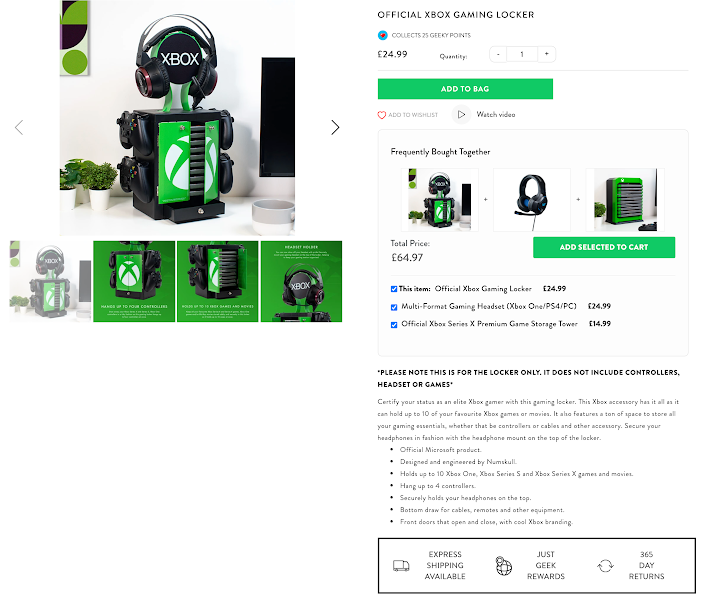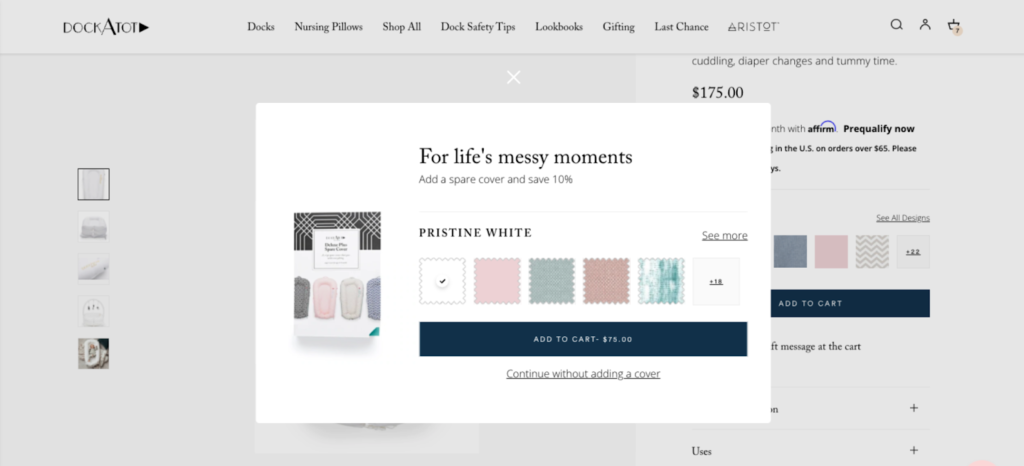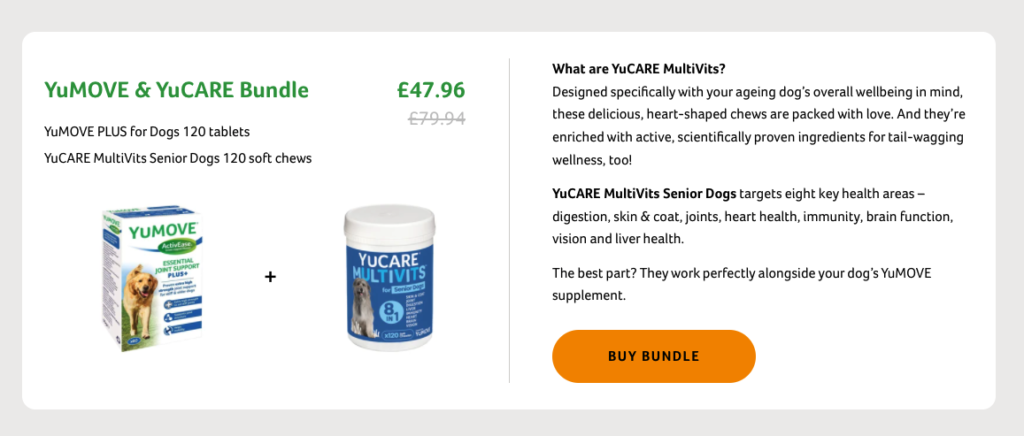Product Bundling Examples for Boosting AOV and Conversions
The quest for increased sales and conversions in ecommerce is ever-changing and has no universal formula for success. Product bundling, however, is a tried and tested strategy to drive sales. Here’s Alex Devos, Data Insights Analyst at Swanky, with tips on how to use product bundling for your store.
Written By
Alex Devos

Product bundling examples aren’t hard to find.
The ecommerce world is littered with them. And for good reason.
Applying a product bundling strategy is a proven way to increase average order value (AOV) and conversion rates.1
Whilst there are some rules of best practice that come with product bundling, it takes time and testing to hone this strategy.
In this article, I’ll dive into the what, why and how of product bundling, before exploring some examples from Swanky’s Growth Accelerator clients. This will ensure you can maximise the value this strategy offers you and your customers.
What is product bundling?
Product bundling is a strategy used to help increase AOV by selling a curated collection of products, typically with a discount to the customer.
With the price of acquisition continually increasing, it is worth considering other avenues for increasing AOV and the return on investment (ROI) of your marketing spend.
Product bundling is one of these avenues.
It’s a technique that numerous brands have utilised in creative ways to improve customer experience and conversion rates. This is largely because product bundles employ a ‘buy more, pay less’ approach that strengthens the perceived value of products to customers.
What are the benefits of product bundling?
Whilst a higher AOV is typically one of the biggest advantages for creating bundles, there are other benefits for your brand too.
1. Increase sales
It is well-documented that a product bundling strategy can increase overall sales. Harvard Business School found this when analysing data from Nintendo, and here at Swanky we’ve seen similar results.1 We’ll explore these examples in a moment.
Research comments on how product bundling is a powerful type of upsell technique, which can be 68% more effective than getting the attention of new customers.2 This saves money on promotion and increases AOV.
2. Increase awareness of new products
Awareness can be achieved by combining new products with more popular stock. This is a great example of how product bundling can be used in tandem with marketing; awareness need not only be built through huge marketing campaigns.
3. Ability to compete with competitors in terms of price
Many people are aware that shoppers are continuously looking for the best deal online. This hunt for the lowest price can often overshadow a customer’s loyalty to a brand. Consequently, being competitive on price is important, but sometimes impossible.
Product bundling can offer a solution. By combining two or more products, your margins may have greater leeway. Additionally, you are providing more perceived value to your customer with this ‘buy more, pay less’ approach.
4. Avoid waste
When you create product bundles you can combine slower-moving stock with faster-moving stock. This ability to be smart with stock avoids waste and saves money on promotion, distribution, and unused inventory.
5. Customer benefits of product bundling
As mentioned briefly above, product bundling doesn’t exclusively benefit a brand. Product bundling can benefit customers too. Perhaps for this exact reason, it’s such a successful strategy.
These benefits include:
– Personalisation
Product bundles can be curated according to a customer’s previous purchases. For example, you could combine a previously purchased item with a new or similar product, for a reduced price.
Providing unique and personalised offers can increase customer loyalty and retention, making this a win-win for all parties.3
Read more about the benefits of ecommerce personalisation.
– Welcome discounts
Providing welcome discounts is nothing new and has come to be expected by online shoppers. Product bundling leverages this expectation and adds increased value by again using the ‘buy more, pay less’ strategy.
How to bundle products
Innumerable suggestions exist online for how to best bundle products together. We’ve rounded up some of the most helpful tips below.
- Pair products smartly, ie. group complementary products and consider carefully how to combine high-value and low-value products.
- Keep it simple: overcomplicating a bundle can lead to confusion for customers and lower conversion rates.
- Always sell products separately, as well as in a bundle. It has been observed by Harvard Business School that if bundled products are unavailable to purchase individually, the product bundle is less likely to be successful.1
- Analyse your site’s data to investigate what organic product bundling is already happening; look at what product combos customers are already putting in their cart. If they are frequently pairing a necklace with matching earrings, could you offer a discount for this combination?
- Conduct customer research. Learn whether consumers would be receptive to trial other products. Who could be most interested in this? Take a look at our article about the discovery process for more tips on how to continually engage with customers and gain their input into your ecommerce strategy.
- Examine where in the customer journey to purchase is best to intervene and offer a product bundle. The only way you can objectively know the answer to this is through ecommerce testing.
Many of these approaches are useful, but best practice will only get you so far. To achieve the best results we recommend a data-led approach.
When deciding whether bundles could add value to your overall ecommerce strategy, or what products to package together, you must lean on what the data says. Only through testing can you fully understand what works best for your ecommerce store and its users. When you understand this, you can unlock the full potential that product bundling offers.
At Swanky, we use data and testing with our clients to optimise and grow their Shopify Plus stores. Testing in ecommerce has a proven track record of delivering huge results. In fact, our conversion rate optimisation (CRO) specialists created a €1M annual turnover growth opportunity for Loop Earplugs through expertly designed and executed on-site testing.
Examples of product bundling from Swanky
1. Just Geek

Aim: To increase AOV
Just Geek is a one-stop shop for TV, movie and merchandising needs. Before working with Swanky, only cross-sell items were promoted on a product detail page (PDP). We saw an opportunity to promote complementary products that could be bundled together by a browsing user.
To achieve this we implemented LimeSpot product bundles. This created dynamic bundles, using data that gave information as to what products were frequently purchased together, and promoted them at a discounted price.
Given the large number of SKUs that Just Geek has, it was essential to use LimeSpot and this data to ensure that the best product bundles were offered to users.
Through this implementation, we saw a 2% increase in AOV and a 3.9% increase in conversion rate.
2. DockATot


Aim: To increase revenue per user (RPU)
DockATot is a global baby brand, most popular for selling its award-winning Dock products.
When analysing the brand’s store, we identified that a large number of users were buying a Dock as their first purchase and then returning three months later to purchase a spare cover.
To explore this buying behaviour further, we created an A/B test with a variant that included a bundle upsell on the Dock PDP, giving customers the option to add a spare cover. We wanted to understand whether implementing this product bundle would see an increase in RPU.
The results say it all. The application of this product bundling strategy saw a 7.09% increase in conversion rate and a 6.9% increase in RPU.
Swanky’s Growth Accelerator team used their data-driven optimisation expertise to improve conversion and RPU across DockATot’s site. Learn more from Head of Strategy, Sammy Fraser, about this exemplary product bundling example.
3. YuMOVE

Aim: To increase sampling of new products
A final product bundling example from our Swanky clients can be seen with YuMOVE. This pet joint supplement brand was adding a new product to its product range, MultiVits.
To increase sampling opportunities, we created a bundle combining its new MultiVits product with its most popular joint supplement product.
This led to an increase in sales of the MultiVits products.
Find out more about how we’ve driven additional sales and revenue for YuMOVE in this case study about our tailored CRO program.
Kickstart your product bundling strategy
There are great benefits to using bundles and upsells to increase AOV and the overall conversion rate on-site. This article has outlined a few product bundling examples that demonstrate just how successful this strategy can be.
However, bundling success for your site will depend on the type of product(s) you’re grouping together and how your customers respond. That’s why you need to test this strategy. A/B testing and multivariate testing is the only way you can fully optimise a product bundling strategy and how it relates to your overall ecommerce strategy.
At Swanky we have an expert team of in-house strategists that can help optimise your ecommerce store and unlock its full potential. We do this by pairing data with experience; testing with in-depth analysis.
Start a conversation with us today about how we can drive transformative results for your ecommerce business.
For reference:
[1] https://hbswk.hbs.edu/item/better-by-the-bundle
[2] https://www.convertcart.com/blog/product-bundling-examples
[3] https://sendpulse.com/support/glossary/product-bundling

